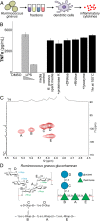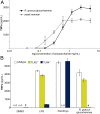Ruminococcus gnavus, a member of the human gut microbiome associated with Crohn's disease, produces an inflammatory polysaccharide
- PMID: 31182571
- PMCID: PMC6601261
- DOI: 10.1073/pnas.1904099116
Ruminococcus gnavus, a member of the human gut microbiome associated with Crohn's disease, produces an inflammatory polysaccharide
Abstract
A substantial and increasing number of human diseases are associated with changes in the gut microbiota, and discovering the molecules and mechanisms underlying these associations represents a major research goal. Multiple studies associate Ruminococcus gnavus, a prevalent gut microbe, with Crohn's disease, a major type of inflammatory bowel disease. We have found that R. gnavus synthesizes and secretes a complex glucorhamnan polysaccharide with a rhamnose backbone and glucose sidechains. Chemical and spectroscopic studies indicated that the glucorhamnan was largely a repeating unit of five sugars with a linear backbone formed from three rhamnose units and a short sidechain composed of two glucose units. The rhamnose backbone is made from 1,2- and 1,3-linked rhamnose units, and the sidechain has a terminal glucose linked to a 1,6-glucose. This glucorhamnan potently induces inflammatory cytokine (TNFα) secretion by dendritic cells, and TNFα secretion is dependent on toll-like receptor 4 (TLR4). We also identify a putative biosynthetic gene cluster for this molecule, which has the four biosynthetic genes needed to convert glucose to rhamnose and the five glycosyl transferases needed to build the repeating pentasaccharide unit of the inflammatory glucorhamnan.
Keywords: inflammatory bowel disease; microbiome; polysaccharide.
Copyright © 2019 the Author(s). Published by PNAS.
Conflict of interest statement
The authors declare no conflict of interest.
Figures



References
-
- Willing B. P., et al. , A pyrosequencing study in twins shows that gastrointestinal microbial profiles vary with inflammatory bowel disease phenotypes. Gastroenterology 139, 1844–1854.e1 (2010). - PubMed
-
- Joossens M., et al. , Dysbiosis of the faecal microbiota in patients with Crohn’s disease and their unaffected relatives. Gut 60, 631–637 (2011). - PubMed
-
- Nishino K., et al. , Analysis of endoscopic brush samples identified mucosa-associated dysbiosis in inflammatory bowel disease. J. Gastroenterol. 53, 95–106 (2018). - PubMed
-
- Png C. W., et al. , Mucolytic bacteria with increased prevalence in IBD mucosa augment in vitro utilization of mucin by other bacteria. Am. J. Gastroenterol. 105, 2420–2428 (2010). - PubMed
Publication types
MeSH terms
Substances
Supplementary concepts
Grants and funding
LinkOut - more resources
Full Text Sources
Medical

